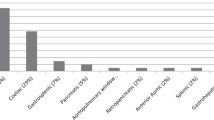Abstract
Purpose
The aim of the current study was to evaluate the utility of F-18-fluoro-2-deoxy-d-glucose (F-18 FDG) positron emission tomography/computed tomography (PET/CT) in assessing patients diagnosed with immunoglobulin G4 (IgG4)-related disease (IgG4-RD) with inflammation of the head and neck glands.
Methods
We reviewed the records of 17 patients (16 men and 1 woman) with IgG4-RD exhibiting inflammation of the head and neck glands (lacrimal or salivary glands; LSG) who were diagnosed by excisional biopsy of the LSG. F-18 FDG PET/CT images were retrospectively evaluated for locations of high FDG accumulation, and the maximum standardized uptake value (SUVmax) of each lesion was calculated.
Results
In 15 of 17 patients (88 %), FDG accumulation was observed in organs outside of the biopsied LSG. High FDG accumulation was most frequently seen in the lymph node (71 %), followed by the non-biopsied LSG (41 %). FDG accumulation was also found in other typically affected organs including the prostate and retroperitoneum (18 %), kidney and lung (12 %), and pancreas (1 %). FDG accumulation was most commonly observed in two lesions outside of the biopsied site (41 %).
Conclusions
Detection of the multi-organ involvement before treatment is important for patients with IgG4-RD. F-18 FDG PET/CT is an effective tool for assessing the location of extra-LSG lesions in patients with IgG4-RD with LSG inflammation.


Similar content being viewed by others
References
Kamisawa T, Okamoto A. IgG4-related sclerosing disease. World J Gastroenterol. 2008;14:3948–55.
Umehara H. A new clinical entity: IgG4-related disease (IgG4-RD) discovered in the 21st century. Intern Med. 2012;51:821–2.
Umehara H, Okazaki K, Masaki Y, Kawano M, Yamamoto M, Saeki T, et al. Comprehensive diagnostic criteria for IgG4-related disease (IgG4-RD), 2011. Mod Rheumatol. 2012;22:21–30.
Fujita A, Sakai O, Chapman MN, Sugimoto H. IgG4-related disease of the head and neck: CT and MR imaging manifestations. Radiographics. 2012;32:1945–58.
Yamamoto M, Takahashi H, Sugai S, Imai K. Clinical and pathological characteristics of Mikulicz’s disease (IgG4-related plasmacytic exocrinopathy). Autoimmun Rev. 2005;4:195–200.
Tanaka A, Moriyama M, Nakashima H, Miyake K, Hayashida JN, Maehara T, et al. Th2 and regulatory immune reactions contribute to IgG4 production and the initiation of Mikulicz disease. Arthritis Rheum. 2012;64:254–63.
Basu S, Zhuang H, Torigian DA, Rosenbaum J, Chen W, Alavi A. Functional imaging of inflammatory diseases using nuclear medicine techniques. Semin Nucl Med. 2009;39:124–45.
Sato M, Okumura T, Shioyama Y, Imura J. Extrapancreatic F-18 FDG accumulation in autoimmune pancreatitis. Ann Nucl Med. 2008;22:215–9.
Kawamura E, Habu D, Higashiyama S, Tsushima H, Shimonishi Y, Nakayama Y, et al. A case of sclerosing cholangitis with autoimmune pancreatitis evaluated by FDG-PET. Ann Nucl Med. 2007;21:223–8.
Nakajo M, Jinnouchi S, Fukukura Y, Tanabe H, Tateno R, Nakajo M. The efficacy of whole-body FDG-PET or PET/CT for autoimmune pancreatitis and associated extrapancreatic autoimmune lesions. Eur J Nucl Med Mol Imaging. 2007;34:2088–95.
Toyoda K, Oba H, Kutomi K, Furui S, Oohara A, Mori H, et al. MR imaging of IgG4-related disease in the head and neck and brain. AJNR Am J Neuroradiol. 2012;33:2136–9.
Yamamoto M, Takahashi H, Ishigami K, Yajima H, Shimizu Y, Tabeya T, et al. Relapse patterns in IgG4-related disease. Ann Rheum Dis. 2012;71:1755.
Taniguchi Y, Ogata K, Inoue K, Terada Y. Clinical implication of FDG-PET/CT in monitoring disease activity in IgG4-related disease. Rheumatology. 2013;52:1508.
Zhang J, Chen H, Ma Y, Xiao Y, Niu N, Lin W, et al. Characterizing IgG4-related disease with 18F-FDG PET/CT: a prospective cohort study. Eur J Nucl Med Mol Imaging. 2014;41:1624–34.
Nakatani K, Nakamoto Y, Togashi K. Utility of FDG PET/CT in IgG4-related systemic disease. Clin Radiol. 2012;67:297–305.
Ebbo M, Grados A, Guedj E, Gobert D, Colavolpe C, Zaidan M, et al. Usefulness of 2-[18F]-fluoro-2-deoxy-d-glucose-positron emission tomography/computed tomography for staging and evaluation of treatment response in IgG4-related disease: a retrospective multicenter study. Arthritis Care Res (Hoboken). 2014;66(1):86–96.
Conflict of interest
There is no conflict of interest.
Author information
Authors and Affiliations
Corresponding author
Rights and permissions
About this article
Cite this article
Tokue, A., Higuchi, T., Arisaka, Y. et al. Role of F-18 FDG PET/CT in assessing IgG4-related disease with inflammation of head and neck glands. Ann Nucl Med 29, 499–505 (2015). https://doi.org/10.1007/s12149-015-0969-3
Received:
Accepted:
Published:
Issue Date:
DOI: https://doi.org/10.1007/s12149-015-0969-3




